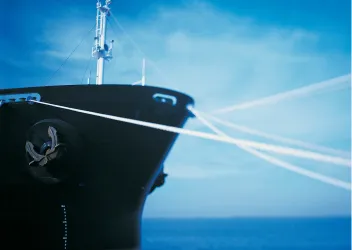Draft new IMO requirements intend to improve mooring safety by introducing additional requirements to selection, arrangement, inspection, maintenance and replacement of mooring equipment including lines from 1 January 2024. This statutory news summarizes these draft mooring requirements.
Relevant for ship owners and managers, yards and design offices.
The IMO to improve mooring safety measures
Draft new requirements to improve the safety of mooring operations were approved by the Maritime Safety Committee (MSC) in 2019. The regulatory tightening follows the many serious and fatal accidents linked to mooring operations, typically caused by manual handling of equipment or mooring line breakage (dynamic snap-back).
Final adoption of the draft new requirements is pending, as IMO meetings are postponed due to the Covid-19 situation.
New SOLAS regulation and associated guidelines
The new requirements are incorporated in the draft amendments to SOLAS regulation II-1/3-8 on towing and mooring equipment, and supported by the following draft guidelines:
- New Guidelines on the design of mooring arrangements and the selection of appropriate mooring equipment and fittings for safe mooring;
- New Guidelines for inspection and maintenance of mooring equipment including lines;
- Revised Guidance on shipboard towing and mooring equipment (MSC.1/Circ. 1175/Rev.1).
The requirements will apply to new cargo and passenger ships constructed on or after 1 January 2024*. Maintenance and inspection requirements will be given retroactive application for all ships.
Implementation requires effort
Implementation of the new mooring requirements will require efforts both for new builds and existing ships – a brief overview:
Consequences for new ships:
- Appropriate and safe-to-use mooring equipment
- Arranged to minimize obstructed access to and operation of the mooring equipment;
- Arranged to minimize obstructed access to working space, and minimize obstructed view of the mooring area;
- Arranged to minimize the need for complex mooring line configurations during the normal operation of the ship;
- Selected and arranged to minimize the need for manual handling of mooring lines under load; and
- Selected and arranged to minimize the exposure of personnel involved in mooring operations to the dynamic loads of mooring lines.
- A more detailed Towing and Mooring Arrangements Plan including information on:
- Deviations, if any, from certain requirements on selection and arrangement of mooring equipment with justification and suitable safety measures;
- Mooring lines (number, strength, size, length, characteristics, and restrictions or limitations);
- Acceptable environmental conditions for normal mooring operations.
The requirements to mooring equipment selection and arrangement are particularly relevant for designers and shipyards and will need to be considered in consultation with the ship owner.
Consequences for ships in operation:
A regime for inspection, maintenance and replacement of mooring equipment to be introduced, including
- Procedures for mooring operations, inspection and maintenance of mooring equipment including mooring lines;
- Procedures for identification and control of mooring lines to facilitate inspection and maintenance;
- Periodic inspection of mooring equipment including lines as part of the onboard maintenance plan/management system.
The requirements to inspection, maintenance and replacement of mooring equipment are mainly relevant for ship owners and operators.
*1) Building contract placed on or after 1 January 2024; or 2) keel laid on or after 1 July 2024; or 3) delivered on or after 1 January 2027.
Recommendations
DNV GL recommends its customers to monitor the outcome of MSC 102 when IMO meetings resume.
DNV GL also recommends owners, operators, designers and builders to start preparing for the new draft requirements and to consider the upcoming requirements to inspection, maintenance and replacement, for example, when purchasing new mooring lines.
References
For full text of IMO documents see:
- IMO new draft and revised guidelines (login as public user required)
Futher information from DNV GL:
Contact
- For customers: DATE – Direct Access to Technical Experts via My Services on Veracity
- Otherwise: use our office locator to find the nearest DNV GL office.
